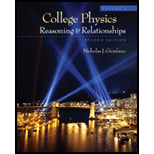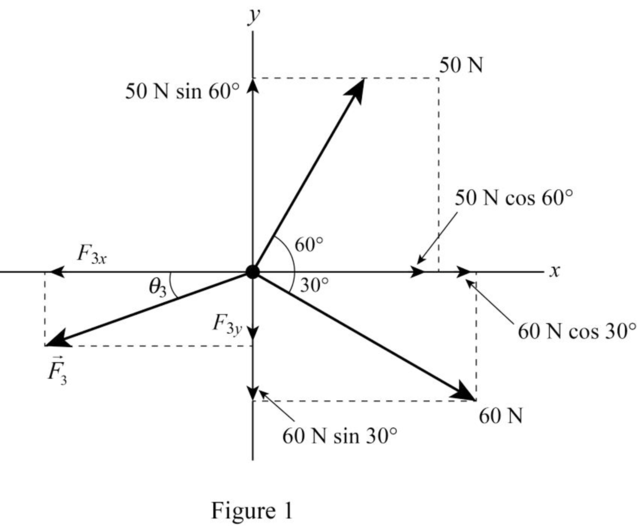
Concept explainers
The magnitude of force
Answer to Problem 2P
The magnitude of force
Explanation of Solution
The figure 1 shows the free body diagram for the particle and the x and y component of three forces

Write the expression for x component of the
Here,
Write the expression for y component of the
Here,
Write the expression for x component of the
Here,
Write the expression for y component of the
Here,
According to static equilibrium, the sum of the x component of the force acting on the particle is,
Here,
According to static equilibrium, the sum of the y component of the force acting on the particle is,
Here,
The net force
The angle acting on the force
Here,
Conclusion:
Substitute
Substitute
Substitute
Substitute
Substitute
Substitute
Substitute
Substitute
Therefore, the magnitude of force
Want to see more full solutions like this?
Chapter 4 Solutions
COLLEGE PHYSICS,VOL.1
- A 520 g model rocket is on a cart that is rolling to the right at a speed of 2.0 m/s. The rocket engine, when it is fired, exerts an 8.0 N vertical thrust on the rocket. Your goal is to have the rocket pass through a small horizontal hoop that is 20 m above the launch point. At what horizontal distance left of the loop should you launch?arrow_forwardThe slope of the 7.9 kN force F is specified as shown in the figure. Express F as a vector in terms of the unit vectors i and j. Assume a = 11, b = 5. Answer: F = (i a b -x i+ MI j) kNarrow_forwardYou've taken your neighbor's young child to the carnival to ride the rides. She wants to ride The Rocket. Eight rocket-shaped cars hang by chains from the outside edge of a large steel disk. A vertical axle through the center of the ride turns the disk, causing the cars to revolve in a circle. You've just finished taking physics, so you decide to figure out the speed of the cars while you wait. You estimate that the disk is 6 m in diameter and the chains are 6 m long. The ride takes 10 s to reach full speed, then the cars swing out until the chains are 30∘ from vertical. What is the car's speed?arrow_forward
- Determine the magnitude of the y-component of force Q (N) if P=108.8 N, Q = 72.5 N , θ= 42.25° and α = 43.45°. Round off only on the final answer expressed in 3 decimal places. Instead of units, indicate the direction of the y-component.arrow_forwardA particle moves 3.0 m along a circle of radius 1.5 m. (a) Through what angle does it rotate? (b) If the particle makes this trip in 1.0 s at a constant speed, what is its angular velocity? (c) What is its acceleration?arrow_forwardF = (-30i + 60j + 60k )kN %3D Forces are concurrent at point O. Determine the magnitude of the resultant of the three vectors. a 71.5 kN b 187 kN F, = (60i – 20j+ 15k )kN c 116 kN d 83.7 kN Determine the angle between F, andF,. F, = (20j – 25k)kN X а 111° b 132° c 69.0° d 21.0° Select the expression that denotes a unit vector in the direction and sense of F,. a 0.625j -0.781k b 0.625i -0.781j c -0.625 j –0.781k d 0.625i +0.781jarrow_forward
- 米 a A long straight wire and a rectangular loop lie in the same plane, as shown in the the figure above, where 11 = 6 A, 12 = 4 A, a = 15 cm, b = 30 cm, c = 30 cm. Find the net force on the loop due to the long wire. N (positive if to the right) Hint: Force on top side and force on bottom side cancel out.arrow_forwardConsider an annular disk rolling down an inclined plane. The annular disk has mass 164 [g], inner radius 9.00 [cm] and outer radius 13.0 [cm]. The inclined plane has a slope that forms angle of 45.7◦ with the ground.a. Suppose that the coefficient of static friction ?s is large enough so that the annular disk rolls without slipping. What's the magnitude of the translational acceleration felt by the annular disk’s center of mass in the direction parallel to the slope?b. What's the minimum value that the coefficient of static friction ?s must take so that the annular disk rolls without slipping?arrow_forwardConsider an annular disk rolling down an inclined plane. The annular disk has mass 154 [g], inner radius 8.00 [cm] and outer radius 12.0 [cm]. The inclined plane has a slope that forms an angle of 44.6° with the ground. A. Suppose that the coefficient of static friction ?s is large enough so that the annular disk rolls without slipping. What is the magnitude of the translation acceleration felt by the annular disk's center of mass in the direction parallel to the slope? B. What is the minimum value that the coefficient of static friction ?s must take so that the annular disk rolls without slipping?arrow_forward
- A 1.5 kg block and a 2.5 kg block are attached to opposite ends of a light rope. The rope hangs over a solid, frictionless pulley that is 33 cm in diameter and has a mass of 0.75 kg. The pulley can be modeled as a cylinder. When the blocks are released, what is the acceleration of the lighter block? Express your answer in meters per second squared.arrow_forwardTwo bugs, Buzz and Crunchy, are siting on a spinning disk on a horizontal plane. Buzz is sitting halfway and Crunchy is sitting at the outer edge as shown. The radius of the disk is 0.80 m and the disk is rotating with an angular speed of 38 rpm. The coefficient of friction between the bugs and the disk are us = 0.80 and uk = 0.60. What is the magnitude of the friction force on Buzz, in Newtons? Buzz has a mass of 2.0 kg (I know, a big bug!). Your answer needs to have 2 significant figures, including the negative sign in your answer if needed. Do not include the positive sign if the answer is positive. No unit is needed in your answer, it is already given in the question statement. Crunchyarrow_forwardA 600 gg model rocket is on a cart that is rolling to the right at a speed of 2.5 m/sm/s. The rocket engine, when it is fired, exerts a 8.0 NN vertical thrust on the rocket. Your goal is to have the rocket pass through a small horizontal hoop that is 20 mm above the launch point. At what horizontal distance left of the hoop should you launch?arrow_forward
 Physics for Scientists and Engineers: Foundations...PhysicsISBN:9781133939146Author:Katz, Debora M.Publisher:Cengage Learning
Physics for Scientists and Engineers: Foundations...PhysicsISBN:9781133939146Author:Katz, Debora M.Publisher:Cengage Learning University Physics Volume 1PhysicsISBN:9781938168277Author:William Moebs, Samuel J. Ling, Jeff SannyPublisher:OpenStax - Rice University
University Physics Volume 1PhysicsISBN:9781938168277Author:William Moebs, Samuel J. Ling, Jeff SannyPublisher:OpenStax - Rice University

